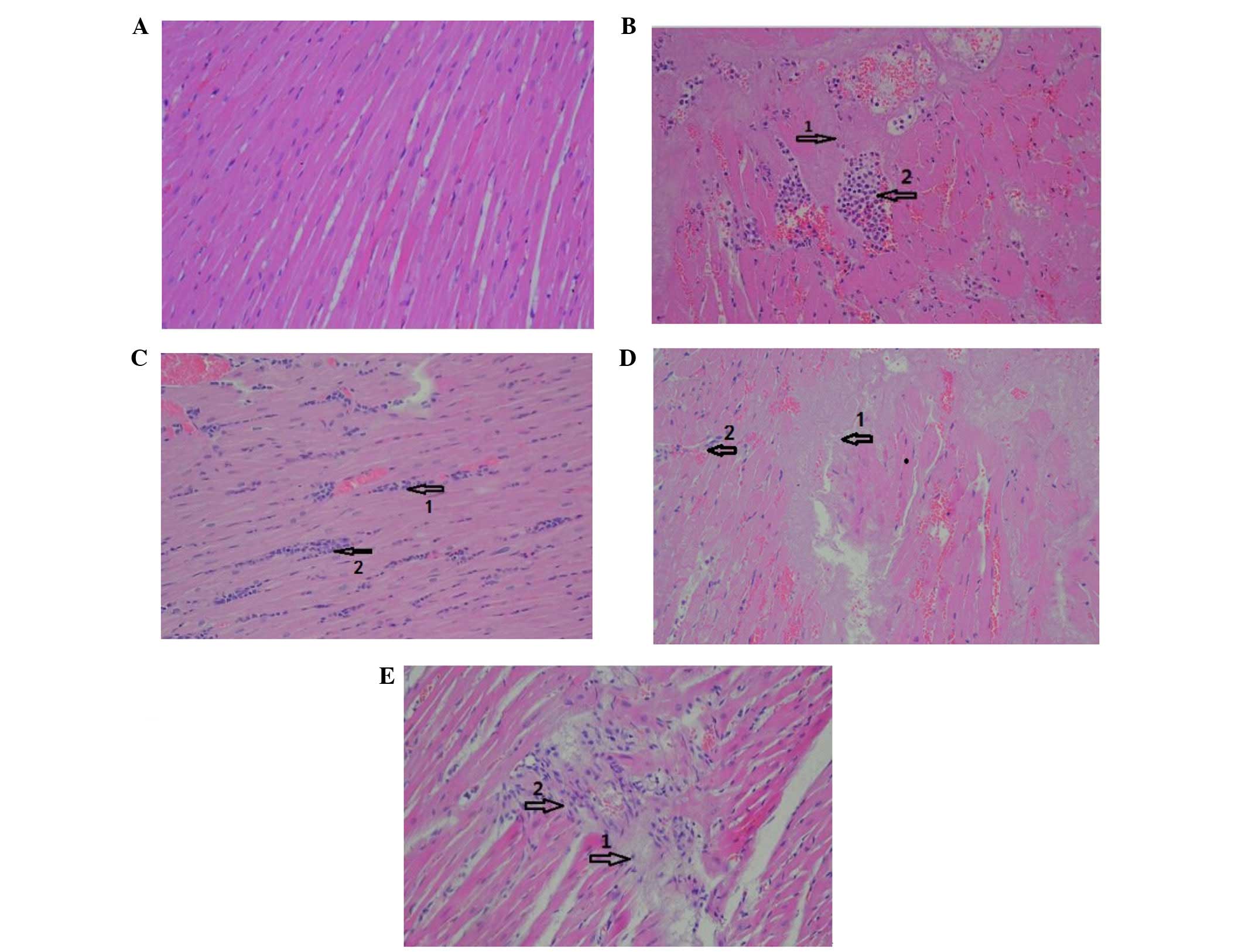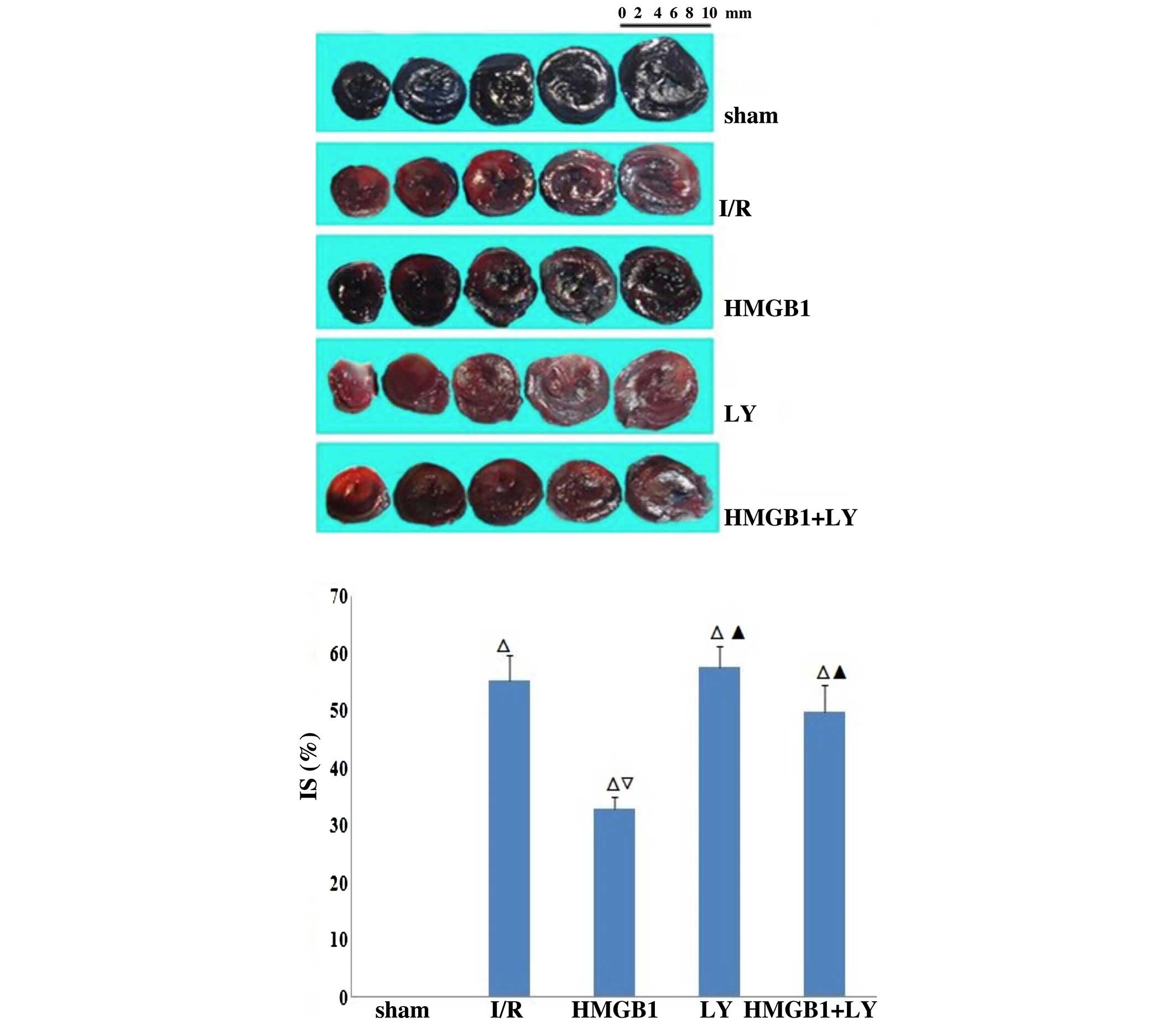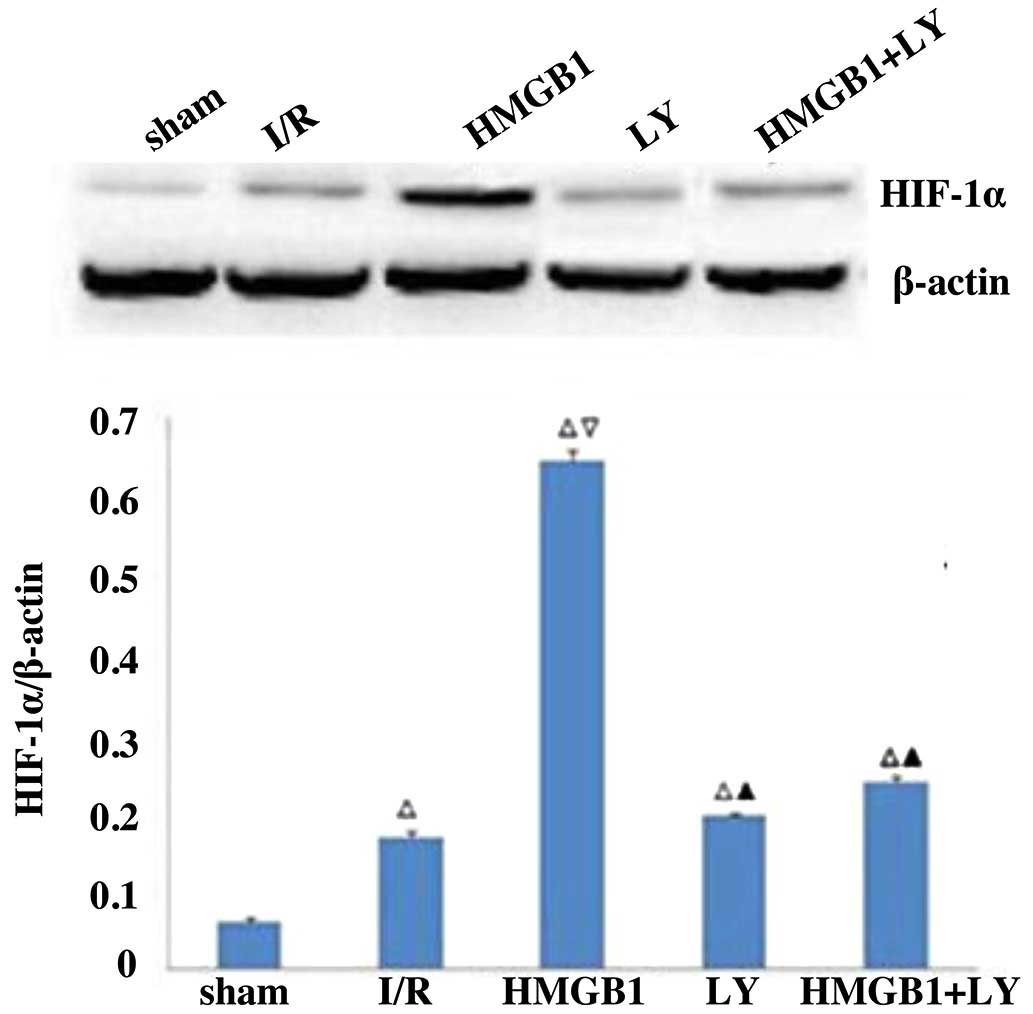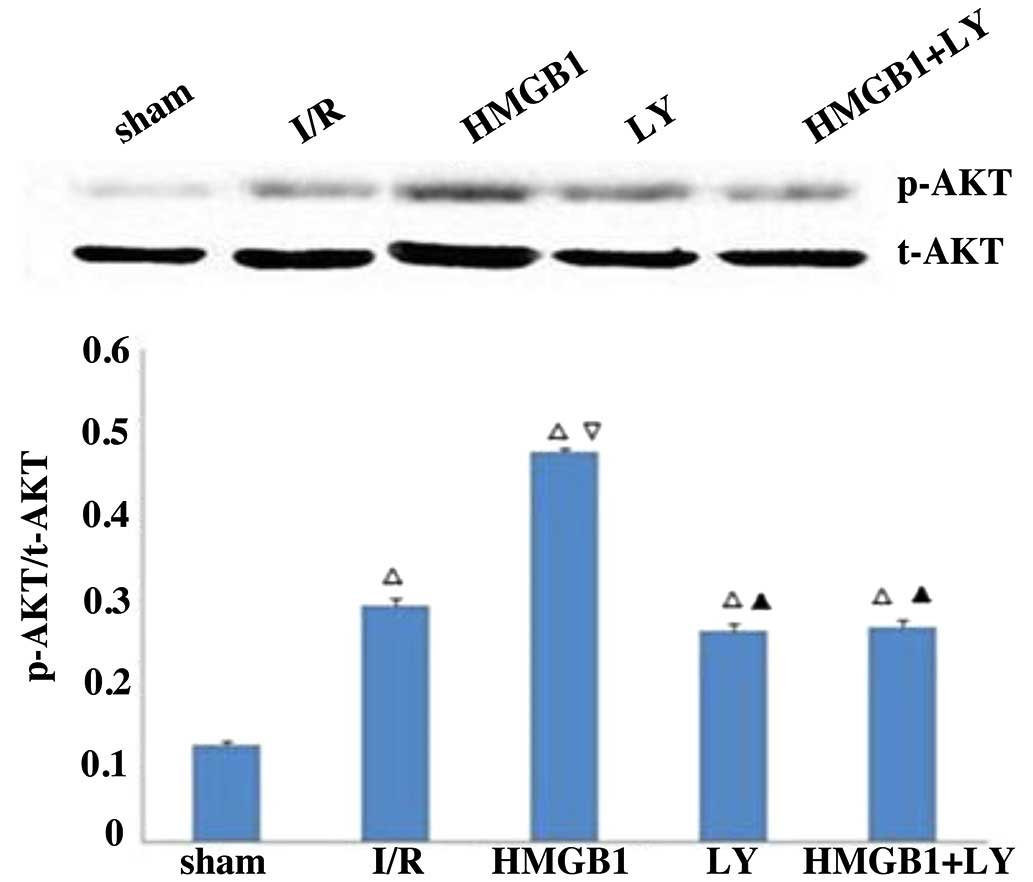|
1
|
Zweiter JL and Talukder MA: The role of
oxidants and free radicals in reperfusion injury. Cardiolvasc Res.
70:181–190. 2006. View Article : Google Scholar
|
|
2
|
Yellon DM and Hausenloy DJ: Myocardial
refusion injury. N Engl J Med. 357:1121–1135. 2007. View Article : Google Scholar : PubMed/NCBI
|
|
3
|
Eltzschig HK and Eckle T: Ischemia and
reperfusion-from mechnism to translation. Nat Med. 17:1391–1401.
2011. View
Article : Google Scholar : PubMed/NCBI
|
|
4
|
Park SW, Kim M, Brown KM, D'Agati VD and
Lee HT: Paneth cell-derives IL-17A causes multiorgan dysfunction
after hepatic ischemia and reperfusion injury. Hepatology.
53:1662–1675. 2011. View Article : Google Scholar : PubMed/NCBI
|
|
5
|
Maes C, Carmeliet G and Schipani E:
Hypoxia-driven pathways in bone development, regeneration and
disease. Nat Rev Rheumatol. 8:358–366. 2012. View Article : Google Scholar : PubMed/NCBI
|
|
6
|
Kasivisvanathan V, Shalhoub J, Lim CS,
Shepherd AC, Thapar A and Davies AH: Hypoxia-inducible factor-1 in
arterial disease: A putative therapeutic target. Curr Vasc
Pharmacol. 9:333–349. 2011. View Article : Google Scholar
|
|
7
|
Weidemann A and Johnson RS: Biology of
HIF-1alpha. Cell Death Differ. 15:621–627. 2008. View Article : Google Scholar : PubMed/NCBI
|
|
8
|
Poynter JA, Manukyan MC, Wang Y, Brewster
BD, Herrmann JL, Weil BR, Abarbanell AM and Meldrum DR: Systemic
pretreatment with dimethyloxalylglycine increases myocardial HIF-1α
and VEGF production and improves functional recovery after acute
ischemia/reperfusion. Surgery. 150:278–283. 2011. View Article : Google Scholar : PubMed/NCBI
|
|
9
|
Yao HC, Liu T, Meng XY, Han QF, Zhang M
and Wang LX: Effect of basic fibroblast growth factor on the
myocardial expression of hypoxia-inducible factor- 1α and vascular
endothelial growth factor following acute myocardial infarction.
Heart Lung Circ. 22:946–951. 2013. View Article : Google Scholar : PubMed/NCBI
|
|
10
|
Lakhan SE, Kirchgessner A and Hofer M:
Inflammatory mechnisms in ischemic stroke: Therapeutic approaches.
J Transl Med. 7:972009. View Article : Google Scholar
|
|
11
|
Oozawa S, Mori S, Kanke T, Takahashi H,
Liu K, Tomono Y, Asanuma M, Miyazaki I, Nishibori M and Sano S:
Effects of HMGB1 on ischemia-reperfusion injury in the rat heart.
Circ J. 72:1178–1184. 2008. View Article : Google Scholar : PubMed/NCBI
|
|
12
|
Deneke SM and Fanburg BL: Normobaric
oxygen toxicity of the lung. N Engl J Med. 303:76–86. 1980.
View Article : Google Scholar : PubMed/NCBI
|
|
13
|
Li J, Kokkola R, Tabibzadeh S, Yang R,
Ochani M, Qiang X, Harris HE, Czura CJ, Wang H, Ulloa L, et al:
Structural basis for the proinflammatory cytokine activity of high
mobility group box 1. Mol Med. 9:37–45. 2003.PubMed/NCBI
|
|
14
|
Kohno T, Anzai T, Naito K, Miyasho T,
Okamoto M, Yokota H, Yamada S, Maekawa Y, Takahashi T, Yoshikawa T,
et al: Role of high-mobility group box 1 protein in post-infarction
healing process and left ventricular remodelling. Cardiovasc Res.
81:565–573. 2009. View Article : Google Scholar
|
|
15
|
Yan XX, Lu L, Peng WH, Wang LJ, Zhang Q,
Zhang RY, Chen QJ and Shen WF: Increased serum HMGB1 level is
associated with coronary artery disease in nondiabetic and type 2
diabetic patients. Atherosclerosis. 205:544–548. 2009. View Article : Google Scholar : PubMed/NCBI
|
|
16
|
Avalos AM, Kiefer K, Tian J, Christensen
S, Shlomchik M, Coyle AJ and Marshak-Rothstein A: Rage-independent
autore-active B cell activation in response to chromatin and
HMGB1/DNA immune complexes. Autoimmunity. 43:103–110. 2010.
View Article : Google Scholar :
|
|
17
|
Ding HS and Yang J: High mobility group
box-1 and cardiovascular diseases. Saudi Med J. 31:486–489.
2010.PubMed/NCBI
|
|
18
|
Yao HC, Zhao AP, Han QF, Wu L, Yao DK and
Wang LX: Correlation between serum high-mobility group box-1 levels
and high-sensitivity C-reactive protein and troponin I in patients
with coronary artery disease. Exp Ther Med. 6:121–124.
2013.PubMed/NCBI
|
|
19
|
Hashimoto T, Ishii J, Kitagawa F, Yamada
S, Hattori K, Okumura M, Naruse H, Motoyama S, Matsui S, Tanaka I,
et al: Circulating high-mobility group box 1 and cardiovascular
mortality in unstable angina and non-ST-segment elevation
myocardial infarction. Atherosclerosis. 221:490–495. 2012.
View Article : Google Scholar : PubMed/NCBI
|
|
20
|
Ulloa L and Messmer D: High-mobility group
box 1 (HMGB1) protein: Friend and foe. Cytokine Growth Factor Rev.
17:189–201. 2006. View Article : Google Scholar : PubMed/NCBI
|
|
21
|
Xu H, Yao Y, Su Z, Yang Y, Kao R, Martin
CM and Rui T: Endogenous HMGB1 contributes to
ischemia-reperfusion-induced myocardial apoptosis by potentiating
the effect of TNF-α/JNK. Am J Physiol Heart Circ Physiol.
300:H913–H921. 2011. View Article : Google Scholar
|
|
22
|
Biscetti F, Ghirlanda G and Flex A:
Therapeutic potential of high mobility group box-1 in ischemic
inury and tissue regeneration. Curr Vasc Pharmacol. 9:677–681.
2011. View Article : Google Scholar : PubMed/NCBI
|
|
23
|
Abarbanell AM, Hartley JA, Herrmann JL,
Weil BR, Wang Y, Manukyan MC, Poynter JA and Meldrum DR: Exogenous
high-mobility group box 1 improves myocardial recovery after acute
global ischemia/reperfusion injury. Surgery. 149:329–335. 2011.
View Article : Google Scholar
|
|
24
|
Hu X, Jiang H, Cui B, Xu C, Lu Z and He B:
Preconditioning with high mobility group box 1 protein protects
against myocardial ischemia-reperfusion injury. Int J Cardiol.
145:111–112. 2010. View Article : Google Scholar
|
|
25
|
National Research Council: Guide for the
Care and Use of Laboratory Animals. National Academic Press;
1996
|
|
26
|
Yao HC, Yang LJ, Han QF, Wang LH, Wu L,
Zhang CY, Tian KL and Zhang M: Postconditioning with simvastatin
decreases the myocardial injury in rats following acute myocardial
ischemia. Exp Ther Med. 9:1166–1170. 2015.PubMed/NCBI
|
|
27
|
Wu YB, Shi LL, Wu YJ, Xu WH, Wang L and
Ren MS: Protective effect of gliclazide on diabetic peripheral
neuropathy through Drp-1 mediated-oxidative stress and apoptosis.
Neurosci Lett. 523:45–49. 2012. View Article : Google Scholar : PubMed/NCBI
|
|
28
|
Swirski FK, Nahrendorf M, Etzrodt M,
Wildgruber M, Cortez-Retamozo V, Panizzi P, Figueiredo JL, Kohler
RH, Chudnovskiy A, Waterman P, et al: Identification of splenic
reservoir monocytes and their deployment to inflammatory sites.
Science. 325:612–616. 2009. View Article : Google Scholar : PubMed/NCBI
|
|
29
|
Kaminski KA, Bonda TA, Korechi J and
Musial WJ: Oidative stress and nuetrophil activation-the two
keystones of ischemia/reperfusion injury. Int J Cardiol. 86:41–59.
2002. View Article : Google Scholar : PubMed/NCBI
|
|
30
|
Zhai Y, Busuttil RW and Kupiec-Weglinski
JW: Liver ischemia and reperfusion injury: New insights into
mechnisms of innate-adaptive immune-mediated tissue inflammation.
Am J Transplant. 11:1563–1569. 2011. View Article : Google Scholar : PubMed/NCBI
|
|
31
|
Jahangiri A, Leifert WR, Kind KL and
McMurchie EJ: Dietary fish oil alters cardiomyocyte Ca2+ dynamics
and antioxidant status. Free Radic Bio Med. 40:1592–1602. 2006.
View Article : Google Scholar
|
|
32
|
Wang Y, Sun J, Liu C and Fang C:
Protective effects of crocetin pretreatment on myocardial injury in
an ischemia/reperfusion rat model. Eur J Pharmacol. 741:290–296.
2014. View Article : Google Scholar : PubMed/NCBI
|
|
33
|
Hool LC: Mechnism for mediating pathology.
Clin Exp Phamacol Physiol. 35:229–234. 2008.
|
|
34
|
Rensing H, Bauer I, Kubulus D, Wolf B,
Winning J, Ziegeler S and Bauer M: Heme oxygenase-1 gene expression
in pericentral hepatocytes through beta-1 adrneoceptor stimulation.
Shock. 21:376–387. 2004. View Article : Google Scholar : PubMed/NCBI
|
|
35
|
Xu Y, Liu B, Zweier JL and He G: Formation
of hydrogen peroxide and reduction of peroxynitrite via dismutation
of superoxide at reperfusion enhances myocardial blood flow and
oxygen consumption in postischemic mouse heart. J Pharmacol Exp
Ther. 327:402–410. 2008. View Article : Google Scholar : PubMed/NCBI
|
|
36
|
van Dijk A, Krijnen PA, Vermond RA, Pronk
A, Spreeuwenberg M, Visser FC, Berney R, Paulus WJ, Hack CE, van
Milligen FJ and Niessen HW: Inhibition of type 2A secretory
phospholipase A2 reduces death of cardiomyocytes in acute
myocardial infarction. Apoptosis. 14:753–763. 2009. View Article : Google Scholar : PubMed/NCBI
|
|
37
|
Matsui Y, Takagi H, Qu X, Abdellatif M,
Sakoda H, Asano T, Levine B and Sadoshima J: Distinct roles of
autophagy in heart during ischemia and reperfusion: Roles of
AMP-activated protein kinase and Beclin 1 in mediating autophagy.
Circ Res. 15:914–922. 2007. View Article : Google Scholar
|
|
38
|
Wang GL, Jiang BH, Rue EA and Semenza GL:
Hypoxia-inducible factor-1 is a basichelix-loop-helix-PAS
heterodimer regulated by cellular tension. Proc Natl Aacad Sci USA.
92:5510–5514. 1995. View Article : Google Scholar
|
|
39
|
Jewell UR, Kvietikova I, Scheid A, Bauer
C, Wenger RH and Gassmann M: Induction of HIF-1alpha in response to
hypoxia is instantaneous. FASEB J. 15:1312–1314. 2001.PubMed/NCBI
|
|
40
|
Zarbin MA: Current concepts in the
pathogenesis of age related macular degeneration. Arch Ophthalmol.
122:598–614. 2004. View Article : Google Scholar : PubMed/NCBI
|
|
41
|
AI-Salam S and Hashmi S: Galectin-1 in
early acute myocardail infarction. PloS One. 9:e869942014.
View Article : Google Scholar
|
|
42
|
Rapino C, Bianchi G, Di Giulio C,
Centurione L, Cacchio M, Antonucci A and Cataldi A: HIF-1alpha
cytoplasmic accumulation is associated with cell death in old rat
cerebral cortex exposed to intermittent hypoxia. Aging Cell.
4:177–185. 2005. View Article : Google Scholar : PubMed/NCBI
|
|
43
|
Siddqi A, Aminova LR and Ratan RR: Hypoxia
inducible factor proly 4-hydroxylase encimes: Center stage in the
battle against hypoxia, metabolic compomise and oxidative stress.
Neurochem Res. 32:931–946. 2007. View Article : Google Scholar
|
|
44
|
Wang Z and Si LY: Hypoxia inducible
factor-1α and vascular endothelial growth factor in the
cardioprotective effects of intermittent hypoxia in rats. Ups J Med
Sci. 118:65–74. 2013. View Article : Google Scholar : PubMed/NCBI
|
|
45
|
Ke Q and Costa M: Hypoxia-inducible
factor-1 (HIF-1). Mol Pharmacol. 70:1469–1480. 2006. View Article : Google Scholar : PubMed/NCBI
|
|
46
|
Hashmi S and Al-Salam S: Hypoxia-inducible
factor-1 alpha in the heart: A double agent? Cardiol Rev.
20:268–273. 2012. View Article : Google Scholar : PubMed/NCBI
|
|
47
|
Robador PA, San José G, Rodríguez C,
Guadall A, Moreno MU, Beaumont J, Fortuño A, Díez J,
Martínez-González J and Zalba G: HIF-1 mediated up-regulation of
cardiotrophin-1 is involved in the survival response of
cardiomyocytes to hypoxia. Cardiovasc Res. 92:247–255. 2011.
View Article : Google Scholar : PubMed/NCBI
|
|
48
|
Blanco Pampín J, García Rivero SA, Otero
Cepeda XL, Vázquez Boquete A, Forteza Vila J and Hinojal Fonseca R:
Immunohistochemical expression of HIF-1alpha in response to early
myocardial ischemia. J Forensic Sci. 51:120–124. 2006. View Article : Google Scholar : PubMed/NCBI
|
|
49
|
Cai Z, Zhong H, Bosch-Marce M, Fox-Talbot
K, Wang L, Wei C, Trush MA and Semenza GL: Complete loss of
ischaemic preconditioning-induced cardioprotection in mice with
partial deficiency of HIF-1 alpha. Cardiovasc Res. 77:463–470.
2008. View Article : Google Scholar
|
|
50
|
Huang Y, Hickey RP, Yeh JL, Liu D, Dadak
A, Young LH, Johnson RS and Giordano FJ: Cardiac myocyte-specific
HIF-1alpha deletion alters vascularization, energy availability,
calcium flux and contractility in the normoxic heart. Faseb J.
18:1138–1140. 2004.PubMed/NCBI
|
|
51
|
Cantley LC: The phosphoinositide 3-kinase
pathway. Science. 296:1655–1657. 2002. View Article : Google Scholar : PubMed/NCBI
|
|
52
|
Wu QL, Shen T, Ma H and Wang JK:
Sufentanil postconditioning protects the myocardium from
ischemia-reperfusion via PI3k/Akt-GSK-3β pathway. J Surg Res.
178:563–570. 2012. View Article : Google Scholar : PubMed/NCBI
|
|
53
|
Yu Y, Jia XJ, Zong QF, Zhang GJ, Ye HW, Hu
J, Gao Q and Guan SD: Remote ischemic postconditioning protects the
heart by upregulating ALDH2 expression levels through the PI3K/Akt
signal pathway. Mol Med Rep. 10:536–542. 2014.PubMed/NCBI
|
|
54
|
Chen K, Li G, Geng F, Zhang Z, Li J, Yang
M, Dong L and Gao F: Berberine reduces ischemia/reperfusion-induced
myocardial appoptosis via activating AMPK and PI3K-Akt signaling in
diabetic rats. Appoptosis. 19:946–957. 2014. View Article : Google Scholar
|
|
55
|
Zhou Y, Wang D, Gao X, Lew K, Richards AM
and Wang P: MTORC2 phosphorylation of Akt1: A possible mechnism for
hydrogen sulfide-induced cardioprotection. PloS One. 9:e996652014.
View Article : Google Scholar
|
|
56
|
Lu C, Ha T, Wang X, Liu L, Zhang X,
Kimbrough EO, Sha Z, Guan M, Schweitzer J, Kalbfleisch J, et al:
The TLR9 ligand, CpG-ODN, induces protection against cerebral
ischemia/reper-fusion injury via activation of PI3K/Akt signaling.
J Am Heart Assoc. 3:e0006292014. View Article : Google Scholar
|
|
57
|
Zuo W, Chen J, Zhang S, Tang J, Liu H,
Zhang D and Chen N: M-H004 prevents toxicity induced by delayed
treatment of tPA in a rat model of focal cerebal ischemia involving
PKA-and PI3K- independent Akt activation. Eur J Neurosci.
39:2107–2118. 2014. View Article : Google Scholar : PubMed/NCBI
|
|
58
|
Chen W, Zheng G, Yang S, Ping W, Fu X,
Zhang N, Wang DW and Wang J: CYP2J2 and EETs protect against
oxidative stress and apopotosis in vivo and in vitro Following Lung
Ischemia/Reperfusion. Cell Physio Biochem. 33:1663–1680. 2014.
View Article : Google Scholar
|













